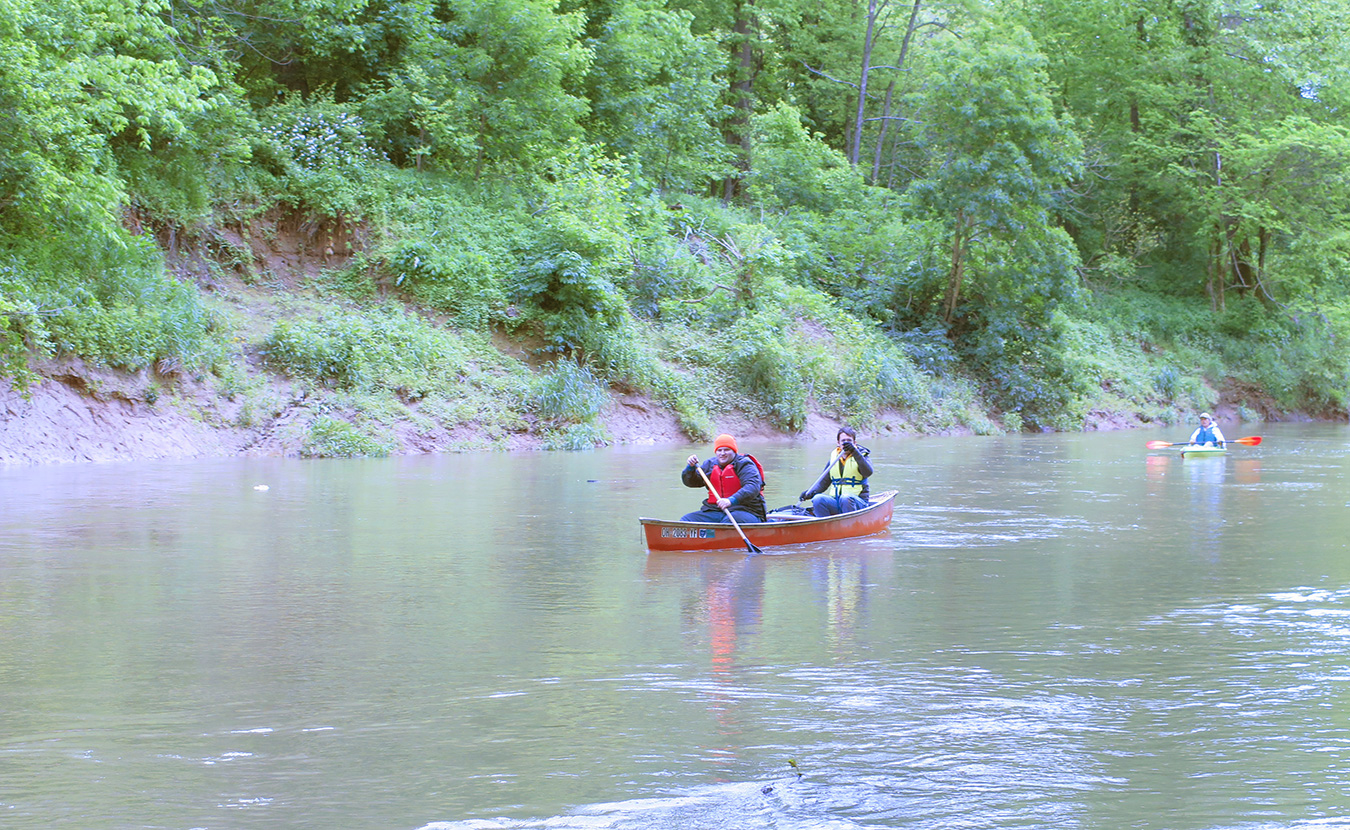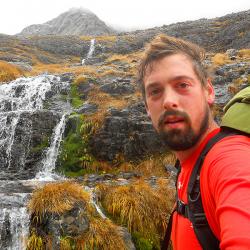Paddling — the practice of powering a floating object with sheer human gumption for the purpose of travel or recreation.
Getting out this summer for a warm weekend on the water is something I recommend for a number of reasons. First off, paddling is fun, family friendly, and a healthy, lifelong skill that almost anyone can enjoy. Learning is not difficult, and numerous clubs and organizations nearby offer courses and outings open to all. Secondly — and I know I’m stepping on a soapbox here — Indiana’s waterways and lakes are in a disastrous state and need to be learned about, cared for, and cleaned up. And the first step to that — getting people on them.
I’ve been working as an outfitter for a few years and know all the excuses people use. Mostly, I hear that getting your butt in a boat is an extensive and expensive process. Some people even think that to enjoy the water you need to spend $30K on a pontoon/petrol-powered colossus with a $400 Yeti Cooler stuffed to the brim with InBev’s latest modification on the aluminum can. But you don’t need to stress about it or spend your annual salary on a newfangled hobbyhorse.
My first boat was an 18-foot fiberglass canoe I found on Craigslist, PFDs (personal floatation devices) and paddles included, for $125. I paddled that boat 2,400 miles down the Mississippi River and still have it (painted like the American flag, it’s named “Ol’ Glory”). And even though I’ve upgraded to a more refined (and expensive) craft, I want to relay that recreational paddling is worth the investment of money and time. The dividends are substantial and the outfitting is fun. So the following are my tips for gearing up, and getting right, your next paddle trip.
Getting outfitted is not hard. Yes, there’s a bit of a learning curve to it, but each trip will teach you what you have forgotten to bring along and what you can do without. For your first few trips, concentrate on the basics and add or take away amenities as you settle into your own camping style. My advice is that you don’t need much. A little food, water, shelter, boat, and paddle, and suddenly you’ve opened up a lifetime supply of river-trail mileage.
The boat
For people who want a recreational boat for calm days on the flat-water lakes, creeks, and rivers of Indiana, my advice is not to overthink it. Don’t get a boat or kayak shorter than 12 feet. If lifting and hauling a larger boat isn’t a problem, I’d even suggest one 14 to 18 feet in length. At these sizes your stroke is more efficient, tracking is better, you can haul all the gear you need, and there are no bends in the water trails around here that you cannot make. That length translates into more fun on the water. Don’t buy a boat because it’s easy to put on the top of your car or because you like the color. Buy it for the times you’re on the water.

Waterford suggests renting a boat before purchasing one in order to learn your needs and wants on the water. | Photo by Limestone Post
Second, invest in a boat with a proper seat. Cheap and flimsy seats will wear on your rump far too quickly. Are you planning to overnight with the boat? Make sure you’ve got storage space for gear. If you want to fish, consider an angler kayak in a drab color with rod holders and a tank well.
If it’s your first outing and you just want to get your feet wet, so to speak, rent or borrow a boat. Renting is cheap and easy, and learning your needs and wants on the water is worth the small investment. Folks in the Bloomington area may want to rent from Indiana University Outdoor Adventures — a 2- to 3-night rental costs only $56 and includes a “car-topper” kit, tie-down straps, PFDs, and paddles. People in other areas should check out IndianaOutfitters.com to find a rental place close to you.
If you’ll be paddling often and want to own — go for it. When you own a boat, you can get on the water easier and more often. Boats for sale are abundant. They’re available on social media, Craigslist, retail stores, and front yards all over southern Indiana. You can easily find an acceptable rig from $400 to $800, and the closer you get to $800 the happier you’ll be on the water. That extra investment gets you better curves on the boat (that allow you to move through the water more efficiently), better seats, and other unnecessary — but nice — comforts such as adjustable foot pegs and a work deck.
Boats can be made of aluminum, fiberglass, Kevlar, wood, plastic (often called Royalex), or a combination of materials. Normally, old fiberglass and plastic boats are heavier but cheaper, whereas the stronger or lighter hulls go up quickly in price. For beginners, I suggest getting only what you really need. Used plastic and aluminum boats are easy to find. But remember when it comes down to it, you can overnight, fish, and enjoy paddling in almost any boat.
Outfitting the boat
If you’re paddling a canoe, get a canoe paddle. Are you in a kayak? Use a kayak paddle. Remember that it’s also a good idea to bring an extra paddle, because there is a reason “up a creek without a paddle” became a saying. Ask your outfitter what length of paddle best fits you and your plans.

If you paddle with a canoe, Waterford says you’ll be able to travel with more gear — almost an entire kitchen. | Photo by Limestone Post
Indiana law requires one PFD per person in a boat. Unless you have grand ambitions of racing or long-distance tours, don’t think about PFDs any further than what you’re willing to spend or what the rental place suggests. Like a lot of outdoor gear, the only thing you get by investing more money in PFDs is a little saved weight, maybe a little more comfort, or a bit more efficiency — all of which are peachy, but unnecessary.
Food, water, and shelter
Possibly the greatest aspect of a paddle trip is the ability to pack entirely too much food and drink. My friends and I take our favorite meats — steak, pork, duck, or venison — and, of course, wrap them in bacon before roasting on a spit. Canoes make bringing extra gear easy. We often have numerous kayakers on a trip and at least one canoe to pack extra gear, beer, and practically an entire kitchen.
Take at least one gallon of water per person per day, with at least one filter or boiling pot to make more. Side note: When a gallon jug is empty, keep it in the tent at night for no-exit-needed bladder relief.
Find a tent, hammock, tarp, or bivy. Or if you trust the clear night skies, just sleep outside in a sleeping bag. There is nothing like a night under the stars.
Planning
If you’ve got all the gear and need info only on where to go and how to get your boat afloat, below are the links to public access points for lakes and rivers in our area.
Indiana Department of Natural Resources (DNR) River Access
Indiana Outfitters River Access
Popular boating places in the area are Blue River and Sugar Creek — but lakes like Monroe, Lemon, or Griffy are more accessible and better for getting acclimated to paddling.
Are you planning a river trip and need to shuttle back and forth to your car? Check out Most High Adventures for a shuttle service — or just hire a friend with a truck and have everybody in your group throw $10 at them.
A few hard lessons I learned early on:
- Paddling alone — I won’t tell you that you can’t, but it’s not the smartest way to learn. In the end, you’re responsible for your own well-being, and if you can handle the risk (i.e., swim, if it comes down to it), I say why not. Conversely, if you’re not certain, bring a friend or hire one of the many professional guides or canoe liveries in the area (i.e., paddling on the Blue River? Try Old Mill Canoe Rentals or Cave County Canoes).
- Always have a way to build a fire. My favorite — a small lighter kept dry in a Ziploc bag. Have one in your pocket and another in a pack.
- You’ll want a rain jacket and pants — after the sun goes down, being wet is not fun.
- Keep a set of dry clothes in a dry bag and don’t wear cotton, because it’s slow to dry and zaps away your body heat when wet.
- Take one pair of shoes for riverside that will get muddy and another dry pair for campside.
- Use a headlamp, flashlight, or lantern so you can see in the dark.
- Make sure you have a first-aid kit. And sunscreen. Getting fried happens fast on the water.
- Paddling lakes: For government-controlled bodies of water, paddlers must have a “non-motorized boat permit.” It’s only $5 annually, and if you paddle without it, the fine can be hefty — trust me, I know. You can pick one up at most Department of Natural Resources (DNR) offices. When I need one, I stop by the Paynetown State Recreation Area office on the way to Lake Monroe.
Other options for success:
- Take friends who will give you an appropriate amount of ribbing when you inevitably go in the drink — but friends who are also willing to gather fleeing gear and stop to build a fire to prevent hypothermia after you get out of cold water.
- Conversely, do not be/invite that friend who can’t handle their booze. I won’t be the guy to tell you that you cannot have a beer out on the water, but I also refuse to babysit. Like every other time in your life, drink responsibly.
- Don’t be an ass, leave no trace. And by no trace, I mean NO trace. Dig a hole to burn a fire in. This acts as a wind block and allows for you to quickly put out and hide any trace of your fire. Quit trying to burn aluminum cans and bottle caps in the campfire. The fire does not get hot enough to fully break them down, and it makes an eyesore — and possibly a footsore for anyone or anything that stumbles upon your camp later.
- When you “make,” dig a hole first and cover that crap up. My least favorite thing about camping around Lake Monroe is finding someone else’s half-decayed sink matter topped with a crown of sodden toilet paper. This may sound obvious, but you’d be surprised how regularly I find foreign ploppings in the forest.
- Put out your fire. If you can’t touch it with your hands, then it is not out. Put it out completely.

Waterford, pictured here paddling a canoe on on the Blue River in southern Indiana, says getting on the water doesn’t have to be an expensive or extensive process. | Photo by Limestone Post
Of course, I haven’t covered everything, because, to a point, I want you to figure out the rest on your own. I hope only to set you up with what you need, and then let you go. Paddling a canoe or kayak through the wilderness has become an important part of my life, and I hope you find it gratifying, too! Paddle safely, folks!
Editor’s note: Check back for Michael Waterford’s suggestions for where to go river paddling — including over-nighters, family-friendly, difficult, easy, and day-trip excursions.




